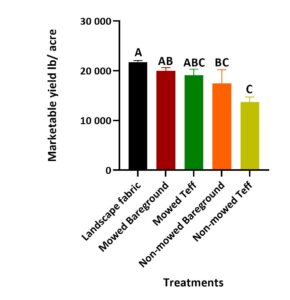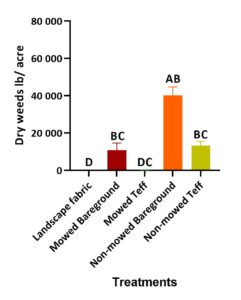Final report for GNC21-318
Project Information
Cucumber beetles and squash bugs transmit the pathogens that cause bacterial wilt and cucurbit yellow vine disease (CYVD), respectively. This pest-disease complex devastates organic cucurbit crops in the NC Region. Organic growers have tried a range of strategies to combat this complex, but with inconsistent results. A new system called mesotunnels – 3.5-ft-high tunnels with nylon-mesh fabric over steel-conduit hoops that stay in place almost all season – keeps out pest insects and the bacterial diseases they carry. Mesotunnels have exciting potential to reduce – or even replace – reliance on organic insecticides while increasing marketable yield for cucurbit crops.
However, organic cucurbit growers have stated that weed control is a potential limiting factor to adopting mesotunnels. Suppressing weeds in the alleys between plastic-mulched crop rows is challenging because the tunnels remain in place for almost the entire season. A living mulch could suppress weeds, build soil quality, and minimize soil erosion. After an inconsistent performance by rye-clover mixtures in an earlier field trial in Iowa, we seeded a cereal grass called teff in 2020 Iowa field trials. Teff suppressed weeds effectively but also reduced crop yield due to competition.
I proposed to determine whether mid-season mowing of teff in the alleys between crop rows could make it suitable as a living mulch for acorn squash in organic mesotunnel systems. I hypothesized that mid-season mowing of teff would suppress weeds effectively while minimizing competition with the crop.
By demonstrating an effective weed control method in mesotunnels, my project provided a potentially attractive alternative management strategy for organic cucurbit growers in the North Central Region. My outreach program shared project results with farmers at a summer field day, at the Iowa State University field day, and through blog posts and videos.
- 200 NC Region growers became aware of mesotunnels’ potential for suppressing pests, reducing insecticide applications, and safeguarding yield.
Our results may have broader impacts by encouraging growers to expand mesotunnel use to other cucurbit and non-cucurbit crops.
Research
The experiments took place at the Iowa State University Horticulture Research Station in Gilbert, Iowa (lat. 42° 6'23.748" N, long. 93°35'23.372" W) in 2022.
The soil was prepared by tillage, broadcast spreading and incorporation of organic compost (Iowa State University Compost Facility, Ames, IA, USA), followed by the spread of the organic fertilizer Sustane (8-2-4) (Sustane Natural Fertilizer, Inc. Cannon Falls, MN, USA) in the rows only. Soil and compost analyses were made to calculate the compost and fertilizer needs to supplement the nitrogen (N), phosphorus (P), and potassium (K) requirements. After the fertilizer application, drip irrigation tape and black plastic mulch were laid on the rows, which were spaced six ft. apart.
Non-treated acorn squash seeds (var. Table Ace) (Seedway LLC, Hall, NY, USA) were planted in 48-cell trays utilizing an organic potting soil mix (Berger OM6 All-Purpose - Organic Mix; Hummert International™, Topeka, KS, USA). The seedlings were hardened off two weeks later in an outdoor shade house for five days before transplanting into the subplots. The weed control treatments were established in the alleys just before transplanting. Transplanting was done with a water wheel.
The experimental design was a randomized complete block design with four subplots for each treatment. The treatments were: Landscape fabric, Non-mowed teff, mowed teff, non-mowed bare ground, and mowed bare ground. Teff was planted at 4lb/acre, and mowed treatments were mowed 21 days after the crop transplanting (and teff planting) with a trimmer mower to a height of 3-4 inches. Teff, weed coverage, and height were measured before mowing.
Immediately after transplanting, 3.5-ft-tall hoops were installed in a zigzag position allowing the covering of the subplots with a net mesh of 60 g/m2 (ProtekNet, DuBois Agrinovation, Saint-Rémi, Quebec, Canada). The nets were 26 ft. wide and approximately 40 ft. long. The nets were tightened and secured by placing sandbags along the perimeter, approximately every 6 ft.
At 35 days after transplanting, mesotunnel nets were removed for two weeks to allow pollination, then re-installed until harvest. Fruit were harvested from all 15 plants in the center row and categorized as marketable and non-marketable. We calculated the mean marketable yield in lb/acre. After harvesting, a quadrat (6 ft2) was placed in one alley per subplot. Weeds and teff were harvested at the soil level, separated, dried in paper bags at 140°F for four days, and then weighed. Analysis of variance of marketable yield and weed biomass was done with GraphPad Prism Software version 9.5.1. The analysis used was an Uncorrected Dunnett's test with a p<0.05 confidence threshold.
Landscape fabric resulted in the highest mean marketable yield but did not differ significantly from either of the mowed treatments. Marketable yield tended to be lower for the non-mowed treatments. We concluded that mowing bare ground and teff 21 days after planting reduced the yield drag observed on the non-mowed treatments and when mowing. Therefore, in my work, early control of teff and the weeds present reduces its potential negative impact on yield due to competition. An additional advantage of mowing early in the season is that the squash vines have not yet run into the alleys, so they are not damaged by mowing.
End-of-season weed biomass was zero in the landscape fabric treatment and negligible in the mowed teff treatment, which means that both treatments had the potential to reduce the weed seed bank. Mowed teff suppresses weed growth early in the season because it emerges and grows fast enough to out-compete the weeds. After mowing, there was a minimal resurgence of weed growth due to the dense stand of teff. Teff is a living mulch, so it covers the soil during the growing season, reducing soil erosion and increasing organic matter. Also, teff produces less waste material than landscape fabric (which requires metal staples to hold it down), making teff potentially more sustainable as a weed management strategy.
This research reveals a new weed control option that could be used under mesotunnels in the organic production of acorn squash and increases the knowledge on the management of teff as a living mulch.
Figure 1. Marketable yield of the different weed control treatments.
Figure 2. Dry weed biomass of the different weed control treatments.
Educational & Outreach Activities
Participation Summary:
Curricula, factsheets, or educational tools: We made two Youtube videos explaining the weed control options under mesotunnels (https://www.youtube.com/watch?v=o9hGgrz71RA and ) and a manual for growers (Gonzalez, J., Gonthier, D., Pethybridge, S., Bessin, R., Nair, A., Zhang, W., Cheng, N., Fiske, K., Gauger, A., Damann, K., Murphy, S., Badilla, S., Mphande, K., and Gleason, M. 2023. Mesotunnels for organic management of cucurbit pests and diseases: tips for growers. NCPA 038, North Central IPM Center. 8pp.). The manual was printed and given to Iowa, New York, and Kentucky farmers. It is also available on the "Current Cucurbit" website: https://www.cucurbit.plantpath.iastate.edu/
Field days: I presented for the North Central Region SARE Administrative Council members, state coordinators, and staff on a field day on July 12th, 2022. And also presented to around 200 farmers, mainly from Iowa, during an ISU field day on August 15th, 2022. Both fields occurred at the Iowa State University Horticulture Research Station in Gilbert, Iowa.
A journal article is in progress. It will include three years of our research. We anticipate submitting the manuscript to HortTechnology.
Project Outcomes
I am working on a paper that will include our three years of research funded by USDA-OREI and NCR-SARE. I intend to publish it in HortTechnology, an open-access journal, meaning the general public will have access to it. I foresee that farmers and extension professionals can benefit from our research since we showed that teff could be used as a living mulch in squash production; this reduced the challenges to incorporate mesotunnels into organic production. Also, the information generated could be used for both organic and non-organic farmers looking to incorporate living mulches in their production systems.
Our OREI research group includes outreach professors from Iowa, Kentucky, and New York who can share our results and experiences with farmers. The research group wrote an 8-page manual for growers called "Mesotunnels for Organic Management of Cucurbit Pests and Diseases: Tips for Growers," which provides practical advice for using mesotunnels and weed control management practices on organic cucurbit production. The manual is available on our website (https://www.cucurbit.plantpath.iastate.edu/). The website will be incorporated into the North Central IPM website in September 2023.
I am more aware of the challenges and benefits of adopting cultural practices such as mesotunnels. I am aware of the insecticide spray reduction potential that mesotunnels can have as well as the time, labor, and resources to install and remove them. The latter are reasons why I think some farmers might hesitate to incorporate them into their management practices. However, studying different aspects of this practice -including economics- could help us to increase the IPM options for organic cucurbit crops in the NC Region.
I also learned that teff is highly effective as a weed-suppressing living mulch for organic squash crops, but that it needs to be managed by mowing within 3 weeks after seeding in order to prevent competition with the squash crop. Teff is relatively new to organic crop management in the NC Region, but may have applications as a living mulch for multiple specialty crops.
Mowing teff or the existing weeds on the alleys between plastic 21 days after acorn squash transplanting (Var. Table Ace) was successful in 2022 under Iowa conditions. However, we recommend testing this practice under other weather and soil conditions and in more sites to have more confidence in its region-wide applicability.

